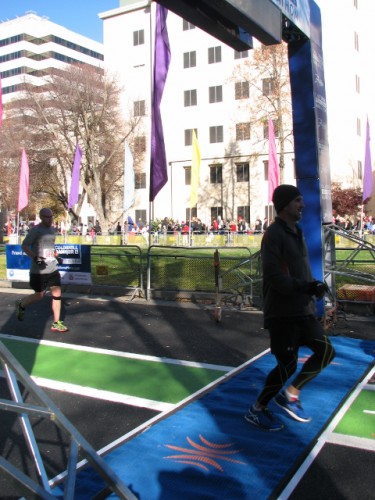The day before Jon’s race, we decided we would head over to the John Muir Mansion in Martinez, CA. John Muir is considered the father of the National Park Service, and I bet many of you didn’t know he lived in a 10,000 square foot mansion at the end of his life! He was born in Scotland in 1838 (shout out to my Scottish roots!) and the family immigrated to Wisconsin in 1849 when Muir was 11 years old. He had a tough childhood, with a father who did not appreciate John’s desire for education. He had to get up in the middle of the night after his father went to bed, in order to read and study.
He and his brother both went to Canada during the Civil War to avoid the draft. Then, after the war, as a young man, John was working in a factory making wagon wheels, where his intelligence led to several inventions that would make production more efficient. Until one day, an industrial accident left him with a cornea that had been pierced by a tool he had been using. John was instructed by his doctor to leave his eyes bandaged and to sit in a darkened room for six weeks. SIX WEEKS! Just sitting there in the dark!
Poor John was about to go insane; the only thing that kept him on this side of sanity was imagining his walks in the countryside. He imagined and remembered an entire childhood of walks in the country alone and with his family, and was able to make it through the completely incapacitated month and a half. His cornea healed.
His six weeks with no vision led to a turning point for John; he decided that he couldn’t continue with the life that he had been living; he wanted to do something that would make a difference. He started down a path of wilderness exploration, and attempting to preserve that wilderness for future generations. He set out on a trek around the United States, first heading south to the southern states, to Cuba, to New York, then making his way out west and stopping Yosemite, where he was so enthralled that he spent the next four years.
Eventually he began to crave human company again, and ended up in the small agricultural town of Martinez, California, where he met his future wife Louisa Strentzel (she was Polish, so shout out to my Polish roots too!), and began working for her family’s fruit farm. He made a fortune growing fruit – apples, pears, figs, quince, wine grapes (Flame Tokay, Muscat of Alexandria and Zinfandel). There were once 2,600 acres on the fruit farm, but that is down to 325 acres now.

The Italianate Mansion John Muir lived in during his later years
John and Louisa married in 1880 and had two daughters together, who he raised to love and appreciate nature. When his father-in-law passed away, he and his wife inherited the 10,000 square foot mansion on the hill. They moved into the mansion in 1890; the house was built in 1883. However, after years living on the farm, Muir began going a bit stir-crazy so his wife offered to take over the daily operations of the farm so Muir could go back to doing what he loved – traipsing through the wilderness and working towards conservation of the nation’s wild areas.
The house is amazing, and has been restored to what it looked like in Muir’s time. It is 14 rooms, with a bell tower above the attic that gives a 360 degree view of what was once the estate. After the earthquake in 1906 damaged the fireplace in the living room, Muir had a gigantic man-fireplace built. It looked a bit out of place in a refined Victorian mansion – it seemed like it belonged more in a mountain lodge. We got to check out the scribble den, which is what Muir called his study, and where many of his preservation writings originated. The self-guided tour also included the bell tower at the top of the house, and the attic space – they had a lot of storage up there!

The front sitting room at the John Muir Mansion – with one of the original marble fireplaces

The fireplace John Muir built after the 1906 earthquake – this one is much more robust
John Muir had some major successes – Yosemite was designated the first National Park in California in 1890, protected for the ages from development. He played a major role in the establishment of Mount Rainier National Park in Washington State.

The Scribble Den – John Muir wrote at the table by the window
He also had some failures – the Tuolumne River was dammed in 1923, flooding the spectacular Hetch Hetchy Valley. Muir had fought the project to build a dam that would provide water to the San Francisco Bay area, but despite his efforts, legislation was passed in 1913 by Woodrow Wilson to move forward with the dam. The defeat was devastating to Muir.

John Muir brought this Sequoia to the property as a seedling from Yosemite
In the end, although he didn’t live to see the fruition of a lot of his life’s dreams, he was instrumental in protection of the Petrified Forest and Grand Canyon National Parks in Arizona, Glacier National Park in Alaska, Yosemite and Sequoia National Parks in California, and in my own backyard, Mount Rainier in Washington. In addition, Muir began a national debate about the importance of preservation, and not allowing the need for resources to blind us to the need to have wild areas preserved for future generations.
The debate continues today, and because of that, when John Muir died on Christmas Eve in 1914, he died a very rich man.





























